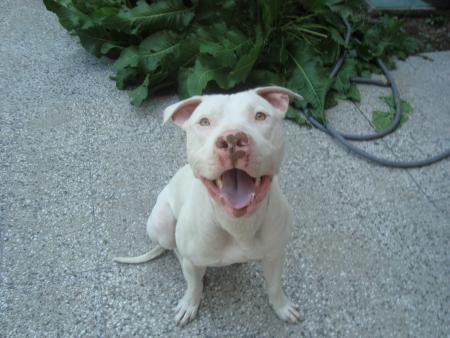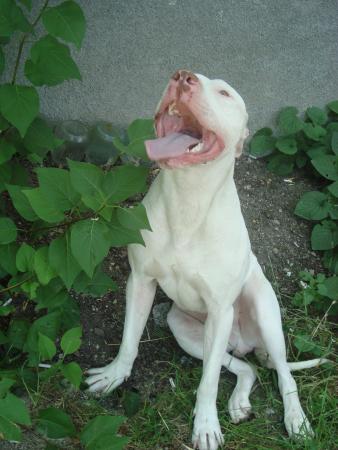Публикувано: 07 July 2009 - 07:55 AM
The American Pit Bull Terrier (APBT)
Like many other common breeds, including Labrador Retrievers, Greyhounds, German Shepherds, and the Parsons (or Jack) Russell Terrier, the American Pit Bull Terrier is essentially a canine athlete. As the UKC points out, during the nineteenth century breeders in the British Isles began to experiment with crosses between terriers and Bulldogs in hopes of finding a dog with the gameness (defined below) of a terrier and the athleticism of a Bulldog (a very different dog from the English Bulldog of today). This original breed, which later resulted in the breeds we now call the APBT, the AST, and the SBT, came to America with immigrants during the late nineteenth century. Just as the Bulldog was originally bred for bull and bear baiting, dog fighting was clearly part of the APBTs original purpose. But as the UKC also notes, the breeds many talents did not go unnoticed, and the APBT was also used as an all-purpose farm dog and family companion.
yellow gameb stumpy bozack
Street-Fighting and Gamebred APBTs
Today, the APBT is bred for a wide variety of purposes from looks and companionship to fighting to nothing in particular, so it is difficult to make generalizations about appearance or purpose. While some APBTs (probably a minority of the overall population) may be directly from fighting lines (game bred), many are genetically far removed from their fighting ancestors. Some are animal aggressive; some are not animal aggressive at all.
NOTE: Like most things in life, we must be open to a certain degree of nuance when thinking about pit bulls. As we note above, pit bulls can exhibit a level of animal aggression ranging from nonexistent to very high or somewhere in between - a statement that is true for all dog breeds. To date, there is no identified fighting gene that determines which dogs will be animal aggressive and which dogs will not. Even pit bulls with fighting histories have proven manageable around other dogs. Knowing how your dog will behave around other dogs is an important part of being a responsible dog owner. More importantly, there is absolutely no relationship between animal aggression and human aggression. Pit bulls might exhibit an above-average tendency toward dog aggression relative to other breeds, but human aggression has never been a normal trait in these breeds. Pit bulls were not bred to fight humans or for guarding purposes. A common fallacy is the notion that pit bulls are the only dogs that have been historically bred for fighting. This is demonstrably false. A large number of dog breeds have been bred to chase, fight, and kill other animals, yet nobody seems to fret about human or animal aggression in Dachshunds, Greyhounds, Whippets, Irish Wolfhounds, Coonhounds, Foxhounds, Beagles, Jack Russell Terriers, and nearly every other dog in the terrier group. Once again, human aggression and animal aggression are entirely unrelated behaviors.
Because breeding purpose varies so widely among APBTs, less consideration is paid to conformation (how closely the dog matches a set physical standard for the breed). As these pictures show, APBTs can look quite different from one another. In general, however, APBTs can weigh as little as 30 lbs. and as much as 70 lbs. News reports of pit bulls weighing in excess of 100 lbs. should be taken with a grain of salt. These dogs are either not pit bulls at all or are mixes of some sort.
An often-overlooked fact of the APBTs history is that human aggressive dogs (man biters in fighting parlance) have been actively culled from bloodlines. In the world of fighting, it is not useful or desirable for a dog to attack handlers or spectators. Not all APBT breeders breed for the pit, though. Some breed for conformation, temperament, weight-pulling, obedience trials, or therapy work. At the foundation of their bloodlines, however, are the same physical and mental characteristicslean and athletic body, agility, courage, and stability.
Cropped ears are not an indicator of a dog's background. Some dogs bred for the pit have cropped ears; some dont. Both ABPT and AST show dogs often have cropped ears, but many others have natural ears.
rex nestle mince ruby
Show and Conformation Bred APBTs
Nowadays people without breeding knowledge are breeding pit bulls for nothing in particular, unusual color (typically red, blue, or merle), general companionship, or to make a quick buck. The animal-welfare community refers to these people as backyard breeders, and they are a major contributor to Americas pet overpopulation problem. In general, their dogs are a little larger than the original APBT. These are the dogs that most commonly wind up in shelters or rescues. Most of them have stable dispositions and make excellent companions.
riley peewee batman angel
Backyard Bred APBTs
The American Staffordshire Terrier (AST or Amstaff)
The AST or Amstaff used to be the same dog as the APBT but was completely taken out of the pit in the mid 1930s. In 1936, the AKC opened its studbooks to a few APBTs that fit their standards and came up with the name Staffordshire Terrier. In 1972, the name was changed to American Staffordshire Terrier to avoid confusion with the newly recognized "Staffordshire Bull Terrier" from England. The only dogs that can properly be called American Staffordshire Terriers are those from AKC-registered bloodlines.
ASTs are primarily bred for conformation and good temperament. They have a set height standard of 18 to 19 inches for males and 17 to 18 inches for females. They usually weigh between 50 to 80 lbs., which should be in proportion to their height. They may be a little stockier than the APBT but not always. The dogs chief requisites, the AKC explains, should be strength unusual for his size, soundness, balance, a strong powerful head, a well-muscled body, and courage that is proverbial.
Red (or Dudley) noses are considered a fault according to the AKCs breed standard, and this physical trait has been bred out of most AST lines. Red-nosed dogs are common in APBT lines. This may help you differentiate between the breeds. If the dog has a red nose, it is more likely to be of APBT than of AST lineage.
chief monk dante barx
American Staffordshire Terriers
Because the AST and APBT have the same ancestors (some are even dual-registered), they have a similar look and similar personalities. Dog-aggression is a potential behavior in both breeds, though its not as strong or common in the AST. The AKCs Complete Dog Book sums it up best:
In mentioning the gameness of the Staffordshire, it is not the intention to tag him as a fighting machine or to praise this characteristic. These points are discussed because they are necessary in giving the correct origin and history of the breed. The good qualities of this dog are many, and it would be difficult for anyone to overstress them. [] As to character, they are game for anything; nevertheless, they should not be held in ill repute merely because some have been taking advantage of this rare courage to use them in the pit as gambling tools. These dogs are docile, and with a little training are even tractable around other dogs. (345)
The same goes for all dogs that come under the banner of the pit bull.



 georeto, в Jun 24 2009, 10:00 PM, написа:
georeto, в Jun 24 2009, 10:00 PM, написа:

 TORMENTOR, в Jun 24 2009, 10:39 PM, написа:
TORMENTOR, в Jun 24 2009, 10:39 PM, написа:


 agalina, в Jul 6 2009, 10:01 PM, написа:
agalina, в Jul 6 2009, 10:01 PM, написа: TORMENTOR, в Jun 24 2009, 10:39 PM, написа:
TORMENTOR, в Jun 24 2009, 10:39 PM, написа:








